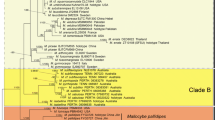Abstract
Achlorophyllous monotropoid plants (Monotropoideae, Ericaceae) are epiparasites that obtain all of their carbon from their host plants via connections with mycorrhizal fungi. The mycorrhizal fungi of the epiparasitic monotropoid Monotropastrum humile var. glaberrima were identified based on mitochondrial, large ribosomal DNA sequences, and were compared with those of another variety, M. humile var. humile. The fungi that inhabit M. humile var. glaberrimum belong to the Thelephoraceae, whereas that of M. humile var. humile is a member of the Russulaceae. Two explanations are possible for this phenomenon: a misunderstanding of the taxonomic position of M. humile var. glaberrimum, or a change in the fungal partner within the Monotropastrum.


Similar content being viewed by others
References
Bidartondo MI, Bruns TD (2001) Extreme specificity in epiparasitic Monotropoideae (Ericaceae): widespread phylogenetic and geographical structure. Mol Ecol 10:2285–2295
Bidartondo MI, Bruns TD (2002) Fine-level mycorrhizal specificity in the Monotropoideae (Ericaceae): specificity for fungal species groups. Mol Ecol 11:557–569
Binder M, Hibbett DS (2002) Higher-level phylogenetic relationships of Homobasidiomycetes (mushroom-forming fungi) inferred from rDNA regions. Mol Phylogenet Evol 22:76–90
Björkman E (1960) Monotropa hypopitys L.—an epiparasite on tree roots. Physiol Plant 13:308–327
Bruns TD, Szaro TM, Gardes M, Cullings KW, Pan JJ, Taylor DL, Horton TR, Kretzer A, Garbelotto M, Li Y (1998) A sequence database for the identification of ectomycorrhizal basidiomycetes by phylogenetic analysis. Mol Ecol 7:257–272
Cullings KW, Szaro TM, Bruns TD (1996) Evolution of extreme specialization within a lineage of ectomycorrhizal epiparasites. Nature 379:63–66
Felsenstein J (1985) Confidence limits on phylogenies: an approach using the bootstrap. Evolution 39:783–791
Felsenstein J (2004) PHYLIP: Phylogeny Inference Package, Version 3.6. University of Washington, Seattle, USA
Felsenstein J, Churchill GA (1996) A Hidden Markov Model approach to variation among sites in rate of evolution. Mol Biol Evol 13:93–104
Hara H (1965) New or noteworthy flowering plants from eastern Himalaya (4). J Jpn Bot 40:97–103
Hsu T-W, Kuoh C-S, Hsieh C-F (1998) Cheilotheca. Flora of Taiwan 2nd edn. 4:5–6
Jackson AP (2004) A reconciliation analysis of host switching in plant-fungal symbiosis. Evolution 58:1909–1923
Kishino H, Hasegawa M (1989) Evaluation of the maximum likelihood estimate of the evolutionary tree topologies from DNA sequence data, and the branching order in Hominoidea. J Mol Evol 29:170–179
Kretzer AM, Bidartondo MI, Grubisha LC, Spatafora JW, Szaro TM, Bruns TD (2000) Regional specialization of Sarcodes sanguinea (Ericaceae) on a single fungal symbiont from the Rhizopogon ellenae (Rhizopogonaceae) species complex. Am J Bot 87:1778–1782
Kristiansen KA, Taylor DL, Kjoller R, Rasmussen HN, Rosendahl S (2001) Identification of mycorrhizal fungi from single pelotons of Dactylorhiza majalis (Orchidaceae) using single-strand conformation polymorphism and mitochondrial ribosomal large subunit DNA sequences. Mol Ecol 10:2089–2093
McKendrick SL, Leake JR, Read DJ (2000) Symbiotic germination and development of myco-heterotrophic plants in nature: transfer of carbon from ectomycorrhizal Salix repens and Betula pendula to the orchid Corallorhiza trifida through shared hyphal connections. New Phytol 145:539–548
Page RDM, Charleston MA (1998) Trees within trees: phylogeny and historical associations. Trend Ecol Evol 13:356–359
Qin H, Wallace GD (in press) Monotropeae. In: Wu Z, Raven PH (eds) Flora of China. vol 14 (Apiaceae through Ericaceae). Science Press, Bei**g, Missouri Botanical Garden Press, St. Louis
Taylor DL (2004) Myco-heterotroph-fungus marriages—is fidelity over-rated? New Phytol 163:217–221
Taylor DL, Bruns TD (1997) Independent, specialized invasions of ectomycorrhizal mutualism by two nonphotosynthetic orchids. Proc Natl Acad Sci USA 94:4510–4515
Taylor DL, Bruns TD (1999) Community structure of ectomycorrhizal fungi in a Pinus muricata forest: minimal overlap between the mature forest and resistant propagule communities. Mol Ecol 8:1837–1850
Taylor DL, Bruns TD, Hodges SA (2004) Evidence for mycorrhizal races in a cheating orchid. Proc R Soc Lond B 271:35–43
Thompson JD, Gibson TJ, Plewniak F, Jeanmougin F, Higgins DG (1997) The ClustalX windows interface: flexible strategies for multiple sequence alignment aided by quality analysis tools. Nucleic Acids Res 24:4876–4882
Wallace GD (1987) Transfer of Eremotropa schiaphila to Monotropastrum (Ericaceae: Monotropoideae). Taxon 36:128–130
White TJ, Bruns TD, Lee S, Taylor J (1990) Amplification and direct sequencing of fungal ribosomal RNA genes for phylogenetics. In: Innis M et al (eds) PCR protocols: a guide to methods and applications. Academic, San Diego, pp 315–322
Acknowledgements
The authors thank Prof. C.-I. Peng of Academica Sinica, Taiwan, for their kind help in obtaining the materials used in this study, and Ms. Y. Nukatsuka of Tohoku University, Japan, for help with the data analyses. Thanks are also due to the late Dr. G. Masuhara of Tsukuba University, Japan, who provided one of the authors (J.Y.) with the opportunity to study mycorrhizae. This study was supported by a Grant-in-Aid from the Ministry of Education, Science, and Culture, Japan, and a grant from the SOKENDAI group research project of the Graduate University for Advanced Studies.
Author information
Authors and Affiliations
Corresponding author
Rights and permissions
About this article
Cite this article
Yokoyama, J., Fukuda, T. & Tsukaya, H. Molecular identification of the mycorrhizal fungi of the epiparasitic plant Monotropastrum humile var. glaberrimum (Ericaceae). J Plant Res 118, 53–56 (2005). https://doi.org/10.1007/s10265-004-0188-9
Received:
Accepted:
Published:
Issue Date:
DOI: https://doi.org/10.1007/s10265-004-0188-9




